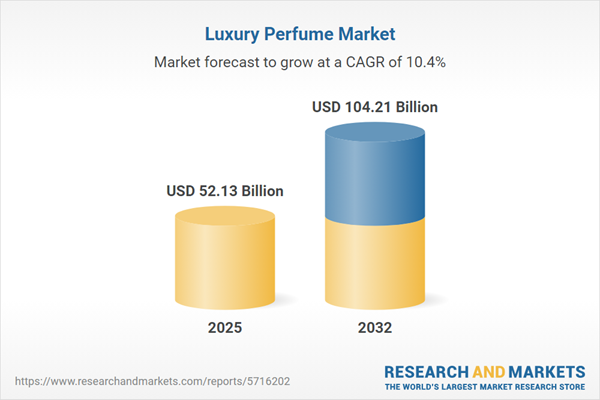Speak directly to the analyst to clarify any post sales queries you may have.
Senior decision-makers in the luxury perfume industry require timely, evidence-based market research to effectively anticipate industry change and shifting consumer expectations. This summary distills targeted intelligence on sector opportunities, challenges, and strategic options for C-level leadership, accelerating confident decision-making.
Market Snapshot: Luxury Perfume Market Size, Growth, and Trajectory
The luxury perfume market is valued at USD 47.15 billion for 2024, with a projected compound annual growth rate of 10.42% through 2032. Expansion is led by both longstanding brands and agile newcomers focused on digital integration and personalized experiences. Secure omnichannel delivery, an embracing of technological advancements, and monitoring rapid consumer preference shifts define the current competitive landscape. Success increasingly depends on adapting models and leveraging data for quick, meaningful responses. Heritage and new brands alike must manage increased regulation and competition from innovative disruptors. Teams positioned to integrate new technologies and optimize consumer channels stand to gain clear advantages in this environment.
Scope & Segmentation: Strategic Insights for Senior Leaders
- Product Types: Analysis covers Eau De Cologne, Eau De Parfum, Eau De Toilette, and Eau Fraîche, enabling leadership to identify high-potential areas for both portfolio optimization and new product introduction.
- Fragrance Families: Segments include floral, citrus, oriental, and woody blends, with insights supporting customization in response to both seasonal trends and distinct consumer demographics.
- Ingredients Origin: Evaluates natural versus synthetic sourcing, highlighting how transparent and sustainable procurement can enhance brand reputation and regulatory compliance alike.
- Target Audience: Reviews men’s, women’s, and unisex preferences, offering direction for differentiated acquisition, loyalty campaigns, and communications aligned with nuanced audience segments.
- Distribution Channels: Assesses exclusive boutiques, travel retail, and online platforms, recommending multifaceted omnichannel approaches and robust direct-to-consumer models for maximum reach.
- Regional Coverage: Provides comparative insights for the Americas, Europe, Asia-Pacific, and Middle East & Africa, empowering leaders to anticipate regulatory changes and leverage local consumer behaviors.
- Company Profiles: Benchmarks innovative and established brands on criteria such as operational agility and collaboration potential, supporting M&A and partnership strategies.
Key Takeaways for Senior Decision-Makers
- Embracing advanced data analytics and strengthening brand narratives are essential to increase target engagement and achieve distinctive market positioning.
- Pursuing greater transparency in ingredient origins and packaging can foster deeper trust and enhance customer loyalty in environmentally conscious segments.
- Integrating new digital technologies, such as artificial intelligence, may accelerate product innovation cycles and rapid response to shifting buyer behaviors.
- Expanding into adjacent segments like premium home scent or luxury personal care supports growth and aligns with consumers’ broader lifestyle aspirations.
- Building strong supplier relationships, including with biotechnological partners, bolsters supply chain resilience and compliance amid shifting global standards.
- Adapting organizational processes and structures strengthens the ability to manage logistics challenges and secure ongoing business continuity.
Tariff Impact: Strategic Adjustments in Procurement and Pricing
Recent U.S. tariff changes have driven luxury perfume companies to re-examine procurement and pricing strategies. The response has included renegotiation of supplier contracts, consideration of nearshore production, and tactical updates to logistics systems, all aimed at cost stability. Vertically integrated brands tend to be more robust in the face of new regulations, while others emphasize flexible launches and operational streamlining. Deepened supplier engagement and agile procurement remain central to margin defense and regulatory alignment.
Methodology & Data Sources
This research draws on interviews with industry executives, stakeholder workshops, and quantitative analysis of global trade data. Digital sentiment analytics are included, ensuring that the findings capture both emerging consumer opinions and evolving industry sentiment to support strategic planning for leadership.
Why This Report Matters: Strategic Benefits for Market Leaders
- Enables executive teams to adapt to evolving luxury fragrance distribution patterns and shifting buyer profiles with confidence.
- Establishes clear benchmarks for navigating changing regulations, operational transformation, and the value of incorporating digital best practices.
- Offers comprehensive supply chain and partnership visibility to bolster growth and deliver robust risk management capabilities in new and established markets.
Conclusion
This analysis equips senior leaders with in-depth market visibility, supporting informed investment and resource decisions that position their organizations for resilient, sustainable growth in the luxury perfume sector.
Additional Product Information:
- Purchase of this report includes 1 year online access with quarterly updates.
- This report can be updated on request. Please contact our Customer Experience team using the Ask a Question widget on our website.
Table of Contents
3. Executive Summary
4. Market Overview
7. Cumulative Impact of Artificial Intelligence 2025
Companies Mentioned
The companies profiled in this Luxury Perfume market report include:- Burberry Group PLC
- Calvin Klein Inc. by PVH Corp.
- Chanel Limited
- Clive Christian Perfume Limited
- Compagnie Financière Richemont SA
- Creed Fragrances by Kering S.A.
- Diptyque SAS
- Dolce & Gabbana S.R.L.
- FLORIS LONDON
- Gianni Versace S.r.l. by Capri Holdings Limited
- Giorgio Armani S.p.A.
- Hermès International S.A
- ITC Limited
- Krigler
- L&L Luxury Company Ltd.
- L'Oréal S.A.
- LVMH Moët Hennessy Louis Vuitton
- Maison Des Parfums
- Prada S.p.A.
- PUIG, S.L.
- Roja Parfums Holdings Limited
- Shiseido Company Limited
- The Estée Lauder Companies Inc.
Table Information
| Report Attribute | Details |
|---|---|
| No. of Pages | 196 |
| Published | November 2025 |
| Forecast Period | 2025 - 2032 |
| Estimated Market Value ( USD | $ 52.13 Billion |
| Forecasted Market Value ( USD | $ 104.21 Billion |
| Compound Annual Growth Rate | 10.4% |
| Regions Covered | Global |
| No. of Companies Mentioned | 24 |









